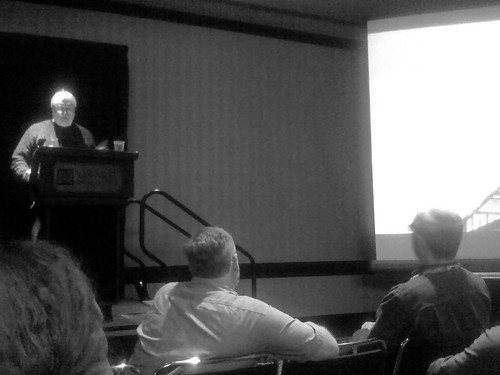OOPSLA '08: Designed by Designer
"Brooks was fooled."
– Dick Gabriel
In OOPSLA 2007, Fred P. Brooks gave a keynote entitled Collaboration and Telecollaboration in Design. I actually wrote a blog entry about it. Overall, I thought that it was a fantastic keynote.
Software Engineering Matters : OOPSLA '07: Collaboration and Telecollaboration in Design:
"There could be multiple architects but there is one chief architect who has the authority to make the final decisions. Even in an open source project like Linux, Linus Torvalds still has the ultimate veto power on what to put in and what not to put in. This almost seems like a dictatorship but if that is what is required for conceptual integrity then it is something that has to be done."
However, there was one over-simplification that Fred Brooks used; he claimed that all of the most innovative products in the world today are created by one individual (or at most two). As examples, he used Albert Enstein, Thomas Edison and the Wright Brothers (the only group of two that Brooks cited).
A couple of people, including Ralph Johnson, pointed out after Brooks's talk that it wasn't necessarily true; in fact, a lot of excellent products today are not created just by one individual. Instead the product usually created by a committee or group and the product would not have been possible without those other individuals.
I definitely agree that Brooks might have oversimplified his examples to get his points across. But then again, he isn't really to blame. Society has always ascribed greatness to one particular individual for each accomplishment. That is just how the world works. And though some might say it isn't unfair for just one individual to claim all the credit, it certainly makes more sense to say that Albert Einstein came up with the theory of relativity than saying that Einstein collaborated with Tom, Dick and Harry and they all helped him to come up with that theory. Besides being a mouthful, it is hard to trace which individuals actually influenced Einstein. If you wanted to, you could even optimistically claim that it was the series of all his interactions with different people that enabled him to formulate his theory. But no one does that because while people realize that such works of marvel aren't the works of an individual, it's best to attribute it to the individual who seemed most responsible for it.
Most people who have left it as that. However, some people might ponder about it for a few more days. And a small minority might even think about it for a few more weeks. But there is likely to be only one individual who would ponder about it for a whole year and write an essay on it – Dick Gabriel : )
So the title of his essay this year is Designed by Designer in which he cites numerous examples (and personal interviews) on why most grand works of art are seldom, if ever, just the work of one careful individual seeing everything from beginning to end. It is insufficient (and unfair) to study the mind of the perceived genius who created that work; instead we need to also study his collaboration with his colleague and how possibly, his work could have just appeared randomly(!) or the work was already there waiting to be discovered and the first person to do so was given the title of genius.
For me, Dick's presentation today was a very interesting one. It was definitely well-planned and well-executed in Dick Gabriel's style – it was artsy, akin to watching a National Geographic or Discovery Channel documentary. It wasn't really a counter-argument to Brooks; rather, I see it as a valid alternative perspective to what Brooks had said. After all, no one really knows what is the best way to create such grand works of art (and similarly no one actually knows how to create complex software perfectly each time). There is always the possibility that a small agile and egalitarian team could produce software of equal quality to that of a big group with organization and bureaucracy. And there is always the possibility that a group wrapped with organizational chains can also produce software of equal quality to that of a small agile group.
Some groups function better with the illusion of a romantic genius to guide them into unknown territories. Other groups prefer to approach everything as a team without a leader – who needs a leaders after all? we could all just take turns since none of us is infallible – and approach each new challenge as a group.
Dick's essay will be available in the OOPSLA proceedings. I will be spending more time reading (and appreciating) it when I get back. There simply isn't enough time during OOPSLA for deep, contemplative reading.
Tweetcomments powered by Disqus
